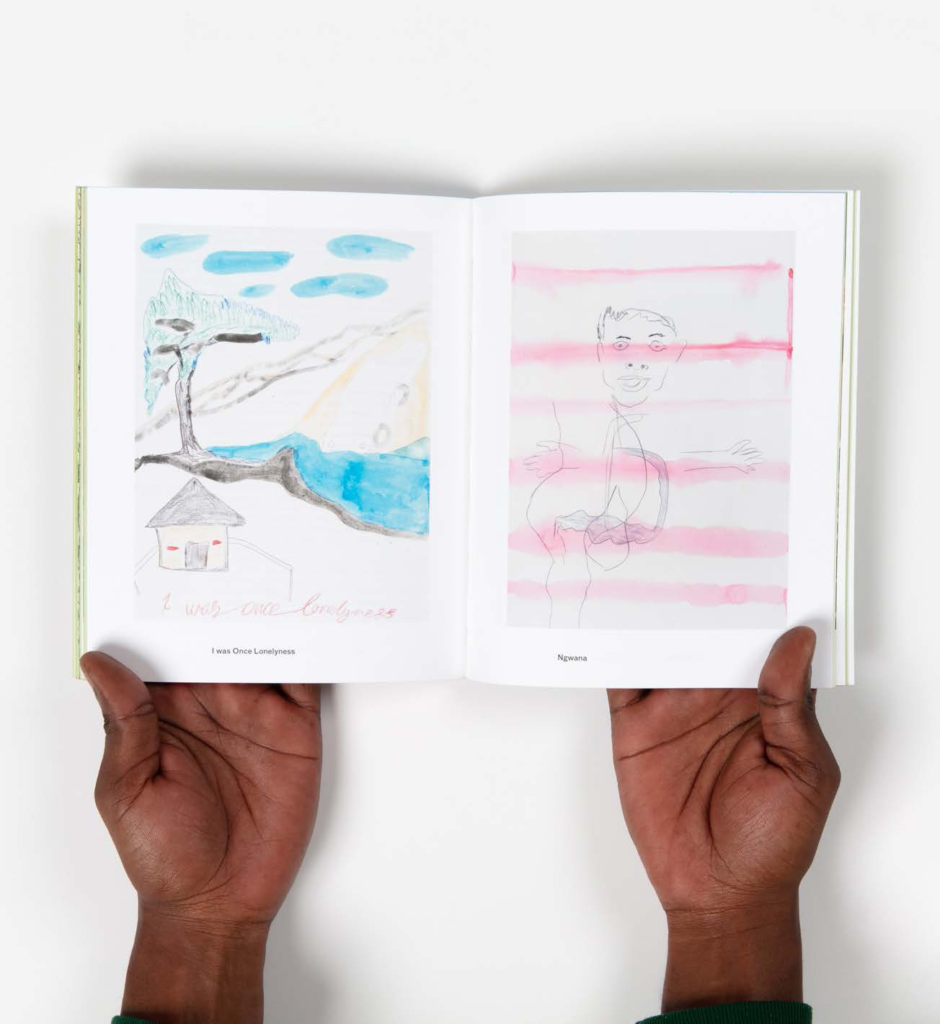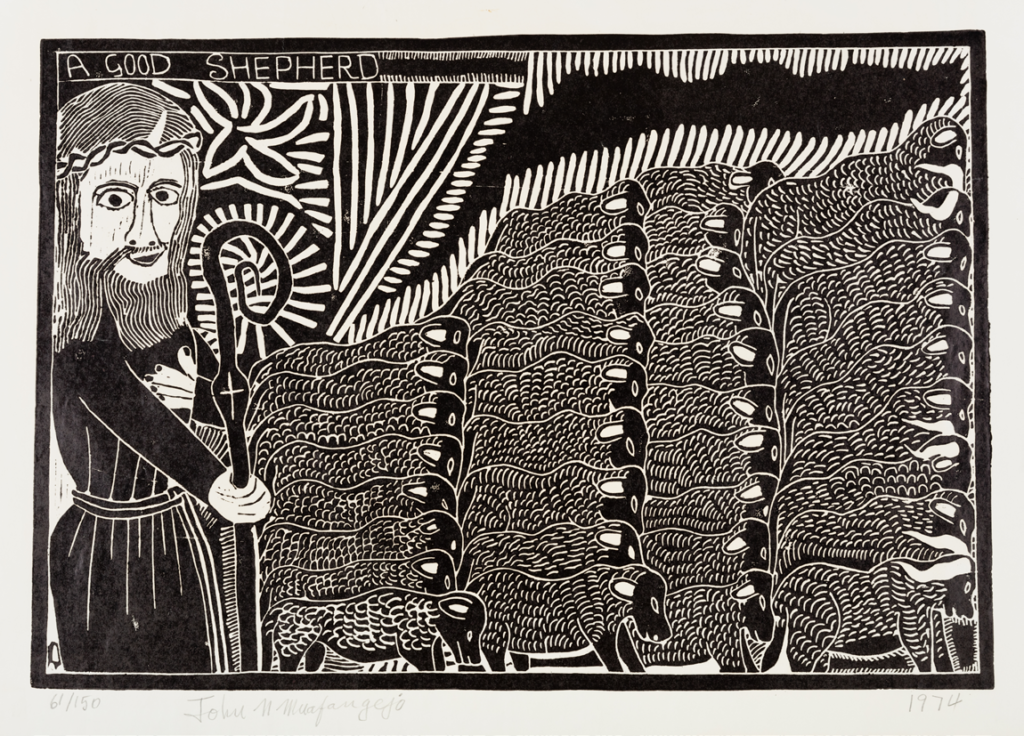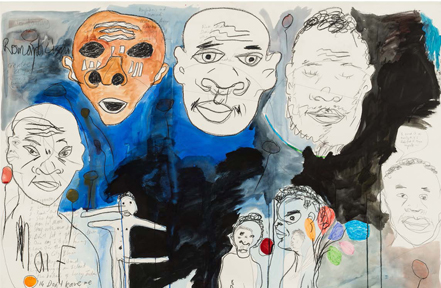Current Stevenson Gallery exhibition Juxtapositions shows striking similarities in practice between Moshekwa Langa and John Muafangejo
By Edward Tsumele, CITYLIFE/ARTS Editor
Whoever came up with the idea of juxtaposing the works of Namibian born and Rorke’s trained artist the late John Muafangejo and that of Amsterdam based South African artist Moshekwa Langa at the Stevenson Gallery Johannesburg must be applauded. You see both artists have a tendency to represent their Characters in ridiculous positions.

Viewing this exhibition that opened on Saturday September 30 2023 at the Parktown North based gallery in Johannesburg did not take me and others that attended, that long to draw a strong connection between the two artist’s works with regards to representing their characters in the case of Langa, in painting, and that of Muafangejo in drawing, as comical figures. I found myself suppressing a loud laughter especially when my eyes landed on Muafangejo’s drawing of two lovers. Both half-dressed, only covering the essentials during a moment of what should be a romantic setting, the man is holding what appears to be a cigar, definitely enjoying his smoking.
Nothing wrong with that at all, but problem is, the woman seems to be not impressed. With her hand stretched out towards the man, she seems to be saying: “Dude, what the fuck, share the damn thing.” If I were him, I would not risk being that selfish, especially during a moment just before passion takes over the situation. The painting whose title reads Love s approaching but much of anything is Very Dangerous (or something to that effect, you will have to excuse me as was overwhelmed by the urge to laugh and therefore forgot to note down the title properly).
And just next to that image is another painting of two men with their manhood exposed, uncovered but they seem not to notice themselves. It is so ridiculous looking at these two silly men in that position of extreme vulnerability. It is almost like the story of the Emperor being naked, but he and his inner circle are completely unaware as the public have fun witnessing the public spectacle of the ruling elite right in front of their eyes.

“Stevenson is pleased to present works by John Muafangejo and Moshekwa Langa in the third iteration of Juxtapositions, the gallery’s series of idiosyncratic two-person exhibitions. The phrase ‘I was lonelyness’, seen first in John Muafangejo’s print Zimbabwe House (1975) and used as the title of his catalogue raisonné of graphic works, was adapted to ‘I was once lonelyness’ by Moshekwa Langa. Inscribed on the bottom of his 2011 drawing, After Muafangejo, the text acts as a direct reference that announces the Namibian printmaker’s influence on Langa, while spotlighting how both artists navigate the themes of isolation, belonging and placemaking across their respective practices,”a curatorial note accompanying the exhibition states.
Muafangejo, often misidentified as South African, was born in Etunda lo Nghadi, Angola, in 1943 and moved to Namibia as a teenager. In 1968–69, he received tutelage at Rorke’s Drift Art and Craft Centre in what is now KwaZulu-Natal, returning five years later to become artist-in-residence. Despite living much of his life in Namibia, he occupies a distinct place in the South African visual history; his images provided the backdrop for the Nelson Mandela concerts at Wembley Stadium in the late 1980s, later winning a string of local prizes.
Both Moshekwa Langa (born 1975) and Muafangejo featured in Impressions from South Africa: 1965 to Now, the Museum of Modern Art’s landmark exhibition in 2011. At the time, critic Leora Maltz-Leca contrasted these artists while underscoring their shared itinerancy, observing that Langa ‘challenges the prevailing boundaries of printmaking but also unravels the very conceit of the nation under which these artists are gathered’.
“Juxtapositions continues to articulate the connections between these two artists, with paintings, drawings and collage created by Langa between 2000 and 2011 presented alongside linocuts by Muafangejo dating back to 1969. Though prints by the latter are pointedly monochromatic while the former makes elliptical use of colour – incorporating maps, adhesives and domestic materials to achieve unconventional surfaces – shared preoccupations emerge across both artists’ strategies around composition, text, portraiture and line.

Ulmann, one of Langa’s word-towers, is populated by loosely vertical lists of names, accompanied and disrupted by the curved lines of the sole figure traced beneath in graphite. Muafangejo’s heavily detailed print, A Good Shepherd, similarly balances rigid composition with ornate curvature, alluding to a tension between singular embodiment and collective involvement, and creating a gestural language that requires the eye to be in constant motion,” further states the curatorial note.
In WELL COME BACK AT ST. MARY’S MISSION IN 1975, Muafangejo demonstrates his characteristic disinterest in realistic perspective, offering figures that vary in size, some depicted in profile while others gaze back at the viewer, refusing to be decentered by the focal point. The accompanying banner of text, acting as a caption, gives further insight into this community Muafangejo found solace in representing over the course of his career.
For Langa, text also functions as a key indicator of patterns of relation and community. Untitled (2002) features pencil inscriptions at the corners, layered behind figures, trapped in speech bubbles, and sometimes fading from view. At the bottom left corner, the song lyric ‘Don’t leave me this way’ floats on the page – a proclamation that could come from any of the floating heads or silhouettes of the figures present, suggestive of mutable dynamics of estrangement and longing.
Working across various media, Langa establishes a language that refers to multiple influences across place and time.
The Limpopo-born artist studied at the Rijksakademie in 1997–98, and while living between Europe and South Africa, had formative encounters in diverse places such as Havana, São Paulo and Venice. He describes the tension of this experience as it relates to language, stating: Maybe some audiences are looking for a particular language form; unfortunately for them, I simply use what I’ve gathered, what I’ve had to learn, what I’ve been force-fed – it’s all part of my language.

Though separated by two decades, both artists’ bodies of work are extensions of complex aesthetic and geographic lineages, and at the same time pave new chapters in regional art history. In Juxtapositions they are brought together to offer the viewer a vocabulary to assuage and understand their own ‘lonelyness’. Their uses of language, distortion and unexpected harmony lend articulation to the possibilities of rediscovery and community while providing room to question the risk of abandonment attendant to closeness.
Juxtapositions, which runs at the gallery till November 24, 2023, is therefore an important exhibition in that not only does it show a connection between a South African contemporary artist, who for all practical reasons calls Europe home, but the fact that artists do influence each other’s practices. Sometimes across generations and geographies, working n different social contexts. This s is indeed the case with this exhibition.
.Juxtapositions is on view till November 24, 2023, Stevenson Gallery Johannesburg, 46 7th Avenue Parktown North 2193 Johannesburg +27 11 403 1055.










